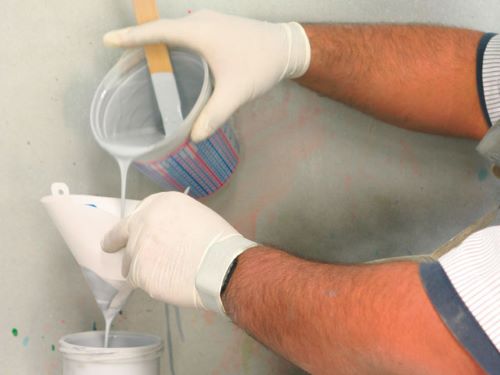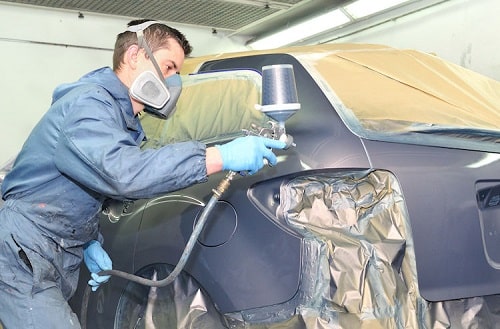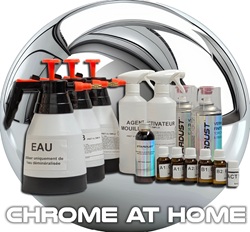 How to prepare the paint before its application ?
How to prepare the paint before its application ?
This article deals with an essential subject which is the mixing and dilution of paints in the context of preparatory work for painting cars, motorcycles, bicycles...
Here we see everything that concerns mixtures with hardeners and thinners for all types of professional paints used in the automotive and also industrial world. We will see the difference between water-based paints and solvent-based paints.
When a paint is delivered "ready to use" then there is absolutely nothing to do, in theory, since the paint is ready to use, that is to say already with the right viscosity and this paint can therefore be put directly into the spray gun, or if necessary, into an airbrush, if it is an airbrush paint.
Paint thinning is adding a thinner to a paint, but it can be a primer or clearcoat just as well. Dilution is done with a compatible solvent. It makes it possible to liquefy the paint, i.e. increase its fluidity or lower its viscosity.
We want to adjust the fluidity of the paint for 2 reasons : first, the paint must be adapted to the tool, most often a spray gun or an airbrush, and therefore it is necessary to lower the viscosity if the paint is too thick to flow properly and smoothly through the nozzle.
Secondly, the dilution allows thick paints to spread well and smooth on the support when they are sprayed.
Dilution varies depending on the type of paint. With solvent-based paints, dilution is easy and theoretically unlimited, especially with so-called "flat bases" or one-component paints.
Of course, the dilution must respect the recommendations laid down in the technical sheet. However, you are free to add as much diluent as you wish. The paint will be more and more liquid and thin, and therefore it will be necessary to refine the sprayed layers, if one does not want to obtain drips. The dilution can also depend on the type of pigments when talking about colored paint in a matt base version.
For example, when airbrushing and drawing extremely fine details, you may need to dilute a white color by up to 200%. For other pigments such as black, a 100% dilution achieves the same viscosity.
Paint mixing and thinning techniques
There are paints, clearcoats and primers that dry with air : the solvents they contain will evaporate during drying and the film made up of dry matter or "solid matter" will solidify. The solidity of the paint will be created when all the polymer cells will touch and weld together, during the disappearance of the solvent or the water which has evaporated and which kept them separated.
In a third case, there are polyurethane paints, which will certainly evaporate in part, to leave room only for the solid and dry material, but whose drying process, or rather hardening, is different. It is with the addition of a second component, which is called the hardener, that the paint will react to create polymerization. The hardener will react with the OH- molecules in the paint by binding at the molecular level. The polymerization of the two-component mixture will create a much harder film and much more resistant, than that of a single-component paint.
The mixing of paints must therefore be done in accordance with the recommendations of the technical data sheet. A single-component paint must be mixed with a thinner if necessary. As for a two-component paint, a mixture is made according to the precise indications of the technical data sheet, by measuring a certain volume or a certain weight of paint which is added to a certain volume or weight of hardener.
There is a distinction between weight and volume that is important to remember. Not all products have a volume equal to their weight, it is the difference in density. In general, this is indicated on the data sheet.
Fortunately, in the world of painting, it is not necessary to have extreme rigor or precision, when mixing paint. The polymerization reaction will still take place, even if there is a 10% difference in accuracy.
Mixing paints is very different in this respect from mixing epoxy resins, for example, for which extreme precision and rigorous mixing is necessary to ensure polymerization of all the molecules in the mixture.
 The dilution of water-based paints
The dilution of water-based paints
Compared to their big sister, solvent-based paints, water-based paints offer much less freedom when it comes to dilution. In general it is not possible, without causing major problems, to dilute beyond 10 or 15%.
The dilution of water-based paints is essentially done with water. Distilled water is used, which sometimes contains a small amount of glycol-type solvent. They are compatible solvents in water and have the same defect as water, that is to say a very slow drying time.
There are of course solvents that are compatible with water and that dry quickly, such as Isopropyl alcohol. However, this solvent can be added in paints in a very limited way, as it causes coagulation reactions.
You have to be very careful when you want to dilute a paint with water and dilute very sparingly. Excess thinner can significantly alter the adhesion and cohesive properties of the paint. That is to say that the water-based paint will lose its resistance and its power to stick to the support.
The main problem will also be an extremely long drying time, with of course the risk of running that accompanies it. The dilution must be done in correlation with the hygrometry and the ambient temperature.
Mixing paints by stirring or stirring
Even when a paint is indicated as ready to use, this does not exempt you from mixing the paint well before using it.
When the can of a paint is left in the same position for a period of time, the different components of the paint separate and spread into different layers, with the heaviest components at the bottom of the can and the heavier components lighter at the top.
It is particularly important to stir the preparation to remove any pigments that may settle at the bottom of the pot. If you want to apply a pearlescent paint without having stirred it, then this paint will be devoid of color, because all the pigments have remained at the bottom of the pot.
Another very effective way is to shake the product vigorously before using it. This is also valid for aerosols: these contain a metal ball and if you do not hear this metal ball when you shake the aerosol, it means that the product is not mixed and that the ball remained stuck in the pigments.
Measurements in paint mixtures
Here too, we are going to talk about primers, clearcoats or paints.
It is often stipulated, on product labels or technical data sheets, this type of indication : "mixture 100: 30”
or
“mix 100 parts clearcoat to 50 parts hardener”
or
“mix 3:1”
between the product and its hardener.
When we talk about "shares", we mean any measurement. It's up to you to choose if you want to mix milliliters, deciliters, liters, kilos, milligrams, or even tons...
Of course, you can and should mix, only the amount you really need. It is therefore not necessary to mix 100 g + 30 g of hardener, if only half is needed. A quick calculation by dividing by 2, will give 130 / 2 = 65 g of product. In the same way if you need more products to paint more surface, then it is enough to multiply the parts of products.
It can also be indicated : "by volume / by weight"
When you want to mix by weight, you must use a scale.
When you want to mix by volume, you have to use a measuring cup.
Of course, if you don't have a measuring cup, but you have the density of the product, then you can do a calculation to know the mixture in converted weight.
Paint Calculator
Calculate your paint needs for each of your projects, for a complete painting, a touch-up, a motorcycle, a Quad... etc., thanks to this article "Paint calculator - Calculate the quantity of paint needed" which will explain to you how estimate the total area of a surface to be painted and how to determine which primer, paint or varnish you will need. Each product involves different and variable consumption, depending on color and thickness. All information is available in the product descriptive pages and also in the technical data sheets.
How do I paint over decals or adhesives ?
Surface preparation techniques
Choosing the right primer or primer




















































































